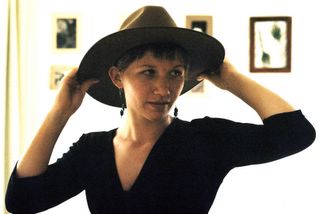On Saturday we took a boat into the
Mekhong Delta, lazily leaving
Phnom Penh on a bus that hooted at everything in its path. When it gets to grit-your-teeth levels we have to keep reminding
eachother that this is not a sign of pent up Cambodian aggression released as road rage, rather it's just a way of letting everyone know you are coming.
Alastair has a photo of me on the top of a river boat drinking a beer at 10am, rows of paddy fields and houses on stilts behind me, watching the water traffic as it chugs by. Incidentally, the Cambodian-Vietnamese
Mekhong border post is tantamount to a luxury resort complete with border guard volley ball nets and I would gladly spend US$10/night to stay there.
We got off the boat in
Chau Doc, as deep in the heart of the Delta as you can be. We were having a problem because all we had were US$20s and US$50s which we couldn't, hand on heart, hand over to a Vietnamese person to pay for our $3 meal. While we were worrying about how rich we were, the
cylco driver we hired (the wizened old stoat) blandly delivered us to wrong guest house. He then proceeded to offer us a romantic sunset (what a joke) and followed us/"showed us the night market". We crossed the road to shake him off. This is more artful than it sounds. There are rules to crossing the road in Asia, these are they:
1. The French colonised Cambodia and Vietnam and, nominally, they drive on the right. However, there will almost always be a lone
bicycle or
motorbike taking advantage of the fast lane created by driving down the wrong side of the road. Watch out for him.
2. Disregard all pedestrian crossings and traffic lights as they are disregarded by everyone else. If you see a policeman directing traffic, wait until he is not looking.
3. Once you have committed to crossing the road you cannot change your mind.
4. Walk at a steady pace into traffic, do not run and do not stop, this will allow oncoming traffic to judge where you will be when they reach you and how to swerve accordingly.
5. Crossing near potholes can make traffic unpredictable.
6. In particular, avoid catching the eye of any
cyclo drivers who will
immediately stop on the
off chance that you wanted a lift. This too makes traffic unpredictable.
Shrugging and waving we left the Old Stoat trying to turn his bicycle around in oncoming traffic and immersed ourselves in
Chau Doc. It is Vietnamese New Year this month and we found a group of performers practising the dragon dance - think of the pantomime cow with two people inside that is actually a dragon but which looks like a lion dancing across a set of stilts 3m in the air - got lost in the Fish Market, emerged and had fish soup at the Night Market. People here live above their shops, there are few cars, the skyline was full of
tv antennae and on Saturdays people sit on chairs in the streets and watch things go by. We were only two of a handful of Westerners.
The next day we found a local bus to take us north to
Vinh Long. Clearly we were the entertainment of the hour and the old women on the bus were eager to know if Alastair and I were together or, if not, whether we could get together (this involved many
lewd hand gestures). As the journey progressed, they wanted to let me know that, since I was single, the skinny man with the Hitler mustache was keen. Also, for Alastair's benefit, an innocent looking family photo album was produced that turned out to be a catalogue of girls in bikinis frolicking on the beach for him to choose from. About 2 hours into this, a French guy got on the bus and saw Al with his photo album (still trying to ask politely "is this your niece?" ) at which point the old women all started nudging me and pointing at the French guy not very subtly. I gestured that he had two huge diamond earrings in one ear and hence wasn't my type - the French guy clearly thought he had got on a porn bus. Subdued for a while, suddenly this old woman gets so excited she's jumping off her seat and she gestures to the French guy's earrings and then to Alastair and they start nudging Al and smiling and pointing. The French guy misses none of this and he says to us with raised eyebrows "we may do that in France, but not in Vietnam".
I have never been so glad to be dropped off on the side of the road in the middle of nowhere in my life!
Vinh Long is another town on the edge of a river. It also has no
ATMs. It does, however, have the only
escalator in the region and a guy who teaches the locals how to get on and off. On Sundays people go to the mall to ride the escalator.
Today we made it to Saigon. We have 20 days left to do Vietnam from bottom to top.

